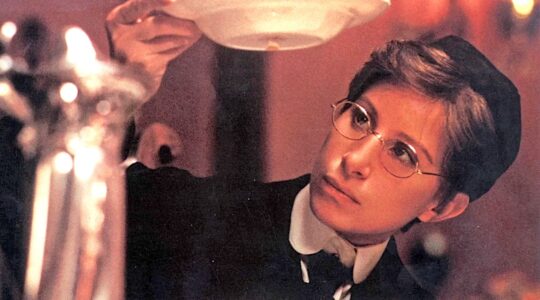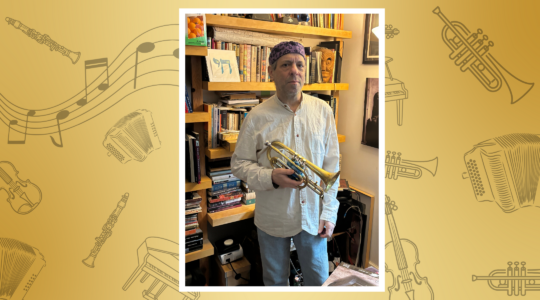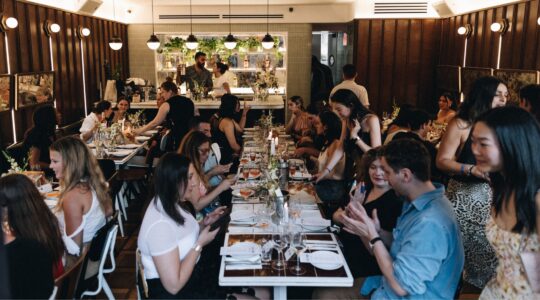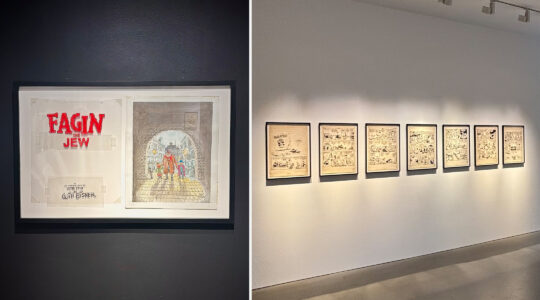The biblical Joseph sports jeans, a multicolored patchwork coat and a fedora. His brothers are lined up behind him in traditional garb the color of sand, in Barbara Hines’ painting “Spotlight on Joseph.” Holding a cell phone, Joseph appears to be taking a selfie, with all his brothers in the background.
Hines’ painting is featured on the cover of the catalog of the new exhibition at the Dr. Bernard Heller Museum at Hebrew Union College – Jewish Institute of Religion, “Relative Relations,” with work by 70 artists exploring the deeply felt bonds between people.
So many lines of connection run through the show. Many of the couples or groups are linked as family, others by community, shared interest or fate. Among the subjects of the art are old married couples who’ve been together for nearly a lifetime, a random ensemble of people on a subway bench, a group of jazz musicians, a son who has embroidered his late mother’s words onto the shirt he has traditionally ripped after her death and the biblical Jacob blessing his sons.
Laura Kruger, the longtime curator of the museum who was awarded an honorary doctorate by HUC last year and has launched more than 120 exhibits, says that “Relative Relations” has been sparking conversations among viewers about their own familial connections.
“There’s no one who has no response, when it comes to families,” she says.
Among the most striking family portraits in the show are two painted gatherings by two artists in which the faces are left blank. The featureless figures, who are otherwise more detailed, lean in to pose. It’s easy to intuit their intimacy from bodily expressions. Perhaps the painters suggest that the viewers see themselves in these scenes from Maj Kalfus’ “Family Gathering,” where well-dressed relations sit and stand around a sofa, and Dorene Beller’s “Family Dinner,” where a multigenerational group shares a celebratory meal in a restaurant, with walls textured in patterns and collaged Russian-language newspapers (Beller’s own family’s immigrant roots are in Russia).
In Mark Berghash’s “Mother and Daughter,” the photographer pieces together the faces and bodies of a mother and daughter, highlighting their clasped hands and the embrace of their arms, as well as the mother’s tender gaze.
Rabbi David Adelson, dean of HUC-JIR/New York, explains in a catalog essay, “We see families born, chosen and imposed.” He writes of family resemblances, quoting the Talmud about how all human beings are made in the Divine image, and yet none resembles another exactly, pointing to “the essential truth of our commonality.”
The art here is accessible, telling stories. Nathan Hilu, a prolific artist whose work might be considered art brut or outsider art, is represented by a spirited black-and-white drawing, “Sephardic Jewish Wedding.” The bride is his mother, and the wedding is in Damascus, Syria in 1919, where Hilu’s grandfather was the chief rabbi. They and others in traditional dress crowd under a chuppah with joy. Kruger has included the vibrant work of Hilu, who passed away last spring, in many museum shows.
Archie Rand’s “The Artists” features three friends in close embrace in front of paint and an easel. There’s something essential and vital about their connection, and exuberant in Rand’s style.
The show depicts ideas of loyalty and compassion, as well as suggestions of family rivalries, broken families and refugees torn from their families. Several artists draw on biblical themes, as Lionel Picker does in the softly colored “Ruth and Naomi,” where the two women embrace when Ruth is determined to stay with her mother-in-law; and Richard McBee does in the poignant “Jacob’s Blessing,” where athe patriarch’s sons are gathered in three groups at his deathbed.
Other artists include Heddy Abramowitz, Deborah Rosenthal, Joyce Ellen Weinstein, Lloyd Wolf, Marc Podwal, who paints “Pharaoh’s Daughter” with a stylized eye looking at baby Moses in a basket for the first time, and David Wander, who depicts himself and his brother as two wide-eyed cows while they were growing up in “Andy and Me”; in another strong work, “Five Threads of Blue,” Wander represents a community of men praying together.
Andi Arnovitz reflects on mothers, both in her stunning artist’s book featuring images and poetry, “Mothers Early Morning Prayer,” unfolded in display, and in “A Quiet Row of Women,” a decoupaged row of nesting dolls.
The show underlines, too, that relationships are not simple, and not always clear to the outsider, as in Susan Sinek’s “My Sister and Brother-in-Law,” with two well-dressed individuals sitting together on opposite ends of a park bench, or perhaps painted at separate moments.
The works are also the stories of the relationships between artist and subject. Several artists remember their parents. In an unusual piece made of steel, “As Life Slips Away,” Janet Goldner welds words out of the steel, recalling her mother’s final days when she took her to lunch and to glimpse the ocean from the car. The lines of steel, with the letters cut out, create a poetry of memory on the wall. Nearby hangs Ken Goldman’s “Tikkun,” in which he embroidered his mother’s words “Take Care of Your Father” on the white shirt he wore as her mourner.
Also featured are works from the extensive HUC archive, including a woodcut from Ruth Leaf depicting “Orchard Street” and its group of intermingling shopkeepers, peddlers, shoppers and walkers; Israeli painter Reuven Rubin’s “Mother and Child”; and “Lunch Hour,” an etching by Morris Topchevsky of two men smoking cigarettes and finishing their lunch in Chicago. Topchevsky was a muralist for the Works Projects Administration during the Great Depression.
Kruger is known to put together shows of representational art with a broad subject, with a lot of paths emanating from a central core idea; it’s a format she has been successful with, whether presenting artwork about the environment (“Terra inFirma”), numerical values and ordering (“Color By Number”) or Jewish spaces (“Envisioning Maps”). Kruger, who has deep connections in the art world, does these shows with much creativity and thoughtfulness.
Not all of the pieces in show are by Jewish artists, and not all the pieces are particularly Jewish in their themes, but many are – and the HUC Museum is one of few venues showcasing contemporary artists doing art that is decidedly and seriously Jewish.
“Relative Relations” is on view at the Dr. Bernard Heller Museum at Hebrew Union College – Jewish Institute of Religion, 1 W. Fourth St. (between Broadway and Mercer Street), New York, through June 30.
The New York Jewish Week brings you the stories behind the headlines, keeping you connected to Jewish life in New York. Help sustain the reporting you trust by donating today.




